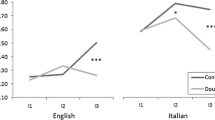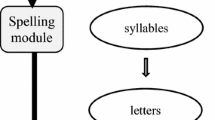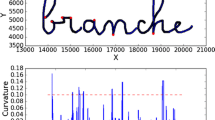Abstract
This study examined whether the graphemic structure of words modulates the timing of handwriting production during the acquisition of writing skills. This is particularly important during the acquisition period because phonological recoding skills are determinant in the elaboration of orthographic representations. First graders wrote seven-letter bi-syllabic words on a digitiser. We measured movement duration and fluency and evaluated reading performance. In Experiment 1, the words varied in number of graphemes and grapheme structure. In Experiment 2, the words varied in graphemic structure but the number of graphemes was held constant. The results revealed that the children wrote the first syllable of the words grapheme-by-grapheme, irrespective of the number of letters that composed them. They prepared the movement to produce the first grapheme before starting to write. The following graphemes were processed on-line. They then prepared the movement to write the second syllable. The progressive decrease of duration and dysfluency values towards the end of the word indicates that the children prepared the entire syllable in advance. Movement time and dysfluency measures presented very similar patterns in the two experiments. Furthermore, there was a significant correlation between reading performance and handwriting measures. The grapheme and syllable structure of the words therefore modulates the timing of motor production during handwriting acquisition. Once the children have learned the phonological recoding rules, they apply them systematically, irrespectively of the size of the graphemes they have to write.
Similar content being viewed by others

References
R. S. Berndt C. Lynne D’Autrechy J. A. Reggia (1994) ArticleTitleFunctional pronunciation units in English words Journal of Experimental Psychology: Learning, Memory and Cognition 20 977–991 Occurrence Handle10.1037/0278-7393.20.4.977
R. S. Berndt J. A. Reggia C. C. Mitchum (1987) ArticleTitleEmpirically derived probabilities for grapheme-to-phoneme correspondences in English Behavior Research Methods, Instruments, & Computers 19 1–9
H. Bogaerts R. G. J. Meulenbroek A. J. W. M. Thomassen (1996) The possible role of the syllable as a processing unit in handwriting M. L. Simner C. G. Leedham A. J. W. M. Thomassen (Eds) Handwriting and drawing reasearch: Basic and applied issues IOS Press Amsterdam 115–126
A. Caramazza G. Miceli (1990) ArticleTitleThe structure of graphemic representations Cognition 37 243–297 Occurrence Handle10.1016/0010-0277(90)90047-N
A. Caramazza G. Miceli G. Villa C. Romani (1987) ArticleTitleThe role of the graphemic buffer in spelling: Evidence from a case of acquired dysgraphia Cognition 26 59–85 Occurrence Handle10.1016/0010-0277(87)90014-X
N. Catach (1980) L’orthographe du français: Traité théorique et pratique Nathan Paris
N. Catach (1995) L’orthographe française. Nathan Paris
M. Coltheart (1978) Lexical access in simple reading tasks G. Underwood (Eds) Strategies of information processing Academic Press London 151–216
Content, A., & Radeau, M. (1988). Données statistiques sur la structure orthographique du Français. Cahiers de Psychologie Cognititve (special issue).
J. Dickerson (1999) ArticleTitleFormat distorsion and word reading: The role of multiletter units Neurocase 5 31–36 Occurrence Handle10.1093/neucas/5.1.31
G. Houghton D. W. Glasspool T. Shallice (1994) Spelling and serial recall: Insights from a competitive queuing model G. D. A. Brown N. C. Ellis (Eds) Handbook of spelling: Theory, process and intervention John Wiley and Sons New York
G. Houghton M. Zorzi (2003) ArticleTitleNormal and impaired spelling in a connectionist dual-route architecture Cognitive Neuropsychology 20 115–162 Occurrence Handle10.1080/02643290242000871
S. A. Joubert A. R. Lecours (2000) ArticleTitleThe role of sublexical graphemic processing in reading Brain and Language 72 1–13 Occurrence Handle10.1006/brln.1999.2279
Kandel, S., Alvarez, C. J., & Vallée, N. (in press). Syllables as processing units in handwriting production. Journal of Experimental Psychology: Human Perception and Performance.
Kandel, S., & Valdois, S. (in press a). Syllables as functional units in a copying task: A visuo-othographic and graphomotor approach. Language and Cognitive Processes
Kandel, S., & Valdois, S. (in press b). French and Spanish-speaking children use different visual and motor units during spelling acquisition. Language and Cognitive Processes.
Kandel, S., & Valdois, S. (2005). The effect of orthographic regularity on children’s handwriting production. Current Psychology Letters: Brain, Behaviour and Cognition, 17(3).
Lefavrais, P., (1967). Test de l’Alouette. Paris: Editions du Centre de Psychologie Appliquée.
H. Martensen E. Maris T. Dijkstra (2003) ArticleTitlePhonological ambiguity and context sensitivity: On sublexical clustering in visual word recognition Journal of Memory and Language 49 375–395 Occurrence Handle10.1016/S0749-596X(03)00068-8
M. McCloskey W. Badecker R. A. Goodman-Schulman D. Aliminosa (1994) ArticleTitleThe structure of graphemic representations in spelling: Evidence from a case of acquired dysgraphia Cognitive Neuropsychology 11 341–392
R. G. J. Meulenbroek G. P. Galen ParticleVan (1986) Movement analysis of repetitive behavior of first, second and third grade primary school children H. S. R. Kao G. P. Galen ParticleVan R. Hoosein (Eds) Graphonomics: Contemporary research in handwriting North Holland Amsterdam 71–92
R. G. J. Meulenbroek G. P. Galen ParticleVan (1988) The acquisition of skilled handwriting: Discontinuous trends in kinematic variables A. M. Cooley J. R. Beech (Eds) Cognition and action in skilled behavior North Holland Amsterdam 273–281
R. G. J. Meulenbroek G. P. Galen ParticleVan (1989) The production of connecting strokes in cursive writing: Developing co-articulation in 8 to 12 year-old children R. Plamondon C. Y. Suen M. L. Simner (Eds) Computer recognition and human production of handwriting World Scientific Singapore
R. G. J. Meulenbroek G. P. Galen ParticleVan (1990) ArticleTitlePerceptual-motor complexity of printed and cursive letters Journal of Experimental Education 58 95–110
W. Mojet (1991) Characteristics of developing handwriting skills in elementary education J. Wann A. M. Wing N. Søvik (Eds) Development of graphic skills Academic Press London 53–75
B. New C. Pallier L. Ferrand R. Matos (2001) ArticleTitleUne base de données lexicales du français contemporain sur internet: Lexique L’Année Psychologique 101 447–462
J. P. Orliaguet L. J. Boë (1993) ArticleTitleThe role of linguistics in the speed of handwriting movements Acta Psychologica 82 103–113 Occurrence Handle10.1016/0001-6918(93)90007-E
Orliaguet, J. P., Zesiger, P., Boë, L. J., & Mounoud, P. (1993). Effects of phonetics on handwriting production: Analysis of reaction time and movement velocity. Paper presented at the sixth international conference on handwriting and drawing, Paris.
R. Peereman A. Content (1997) ArticleTitleOrthographic and phonological neighborhood in naming: Not all neighbors are equally influential in orthographic space Journal of Memory and Language 37 382–410 Occurrence Handle10.1006/jmla.1997.2516
R. Peereman A. Content (1999) ArticleTitleLEXOP: A lexical data base providing orthography-phonology statistics for French monosyllabic words Behavior Research Methods, Instruments, & Computers 31 376–379
C. A. Perfetti (1992) The representation problem in reading acquisition P. B. Gough L. C. Ehri R. Treiman (Eds) Reading acquisition Lawrence Erlbaum Associates Hillsdale, N.J 145–174
L.R. Rabiner B. Gold (1975) Theory and application of digital signal processing. Prentice-Hall NJ
B. Rapp D. Kong (2002) ArticleTitleRevealing the component functions of the graphemic buffer Brain and Language 83 112–113
K. Rastle M. Coltheart (1998) ArticleTitleWhammy and double whammy: Length effects in nonword naming Psychonomic Bulletin Review 5 277–282
Rey, A., & Schiller, N. O. (in press). Graphemic complexity and multiple print-to-sound associations in visual word recognition. Memory & Cognition.
A. Rey J. C. Ziegler A. M. Jacobs (2000) ArticleTitleGraphemes are perceptual reading units Cognition 75 IssueID1 B1–B12 Occurrence Handle10.1016/S0010-0277(99)00078-5
P. H. K. Seymour M. Aro J. M. Erskine (2003) ArticleTitleFoundation of literacy acquisition in European orthographies British Journal of Psychology 94 IssueID2 143–174 Occurrence Handle10.1348/000712603321661859
D. L. Share (1995) ArticleTitlePhonological recoding and self-teaching: Sine qua non of reading acquisition Cognition 55 151–218 Occurrence Handle10.1016/0010-0277(94)00645-2
D. L. Share (1999) ArticleTitlePhonological recoding and orthographic learning: A direct test of the self-teaching hypothesis Journal of Experimental Child Psychology 72 95–129 Occurrence Handle10.1006/jecp.1998.2481
N. Søvik O. Arntzen M. Samuelstuen M. Heggberget (1994) Relations between linguistic wordgroups and writing C. Faure G. Lorette A. Vinter (Eds) Advances in handwriting and drawing: A multidisciplinary approach Europia Paris 231–246
L. Sprenger-Charolles L. Siegel D. Béchennec W. Serniclaes (2003) ArticleTitleDevelopment of phonological and orthographic processing in reading aloud, in silent reading, and in spelling: A four-year longitudinal study Journal of Experimental Child Psychology 84 194–217 Occurrence Handle10.1016/S0022-0965(03)00024-9
M. J. Tainturier B. Rapp (2004) ArticleTitleComplex graphemes as funtional spelling units: Evidence from acquired dysgraphia Neurocase 10 IssueID2 122–131 Occurrence Handle10.1080/13554790490497238
H. L. Teulings A. J. W. M. Thomassen G. P. Galen ParticleVan (1983) ArticleTitlePreparation of partly precued handwriting movements: The size of movement units in handwriting Acta Psychologica 54 165–177 Occurrence Handle10.1016/0001-6918(83)90031-8
G. P. Galen ParticleVan (1991) ArticleTitleHandwriting: Issues for a psychomotor theory Human Movement Science 10 165–191
G. P. Galen ParticleVan R. G. Meulenbroek H. Hylkema (1986) On the simultaneous processing of words, letters and strokes in handwriting: Evidence for a mixed linear and parallel model H. S. R. Kao G. P. Galen ParticleVan R. Hoosain (Eds) Graphonomics: Contemporary research in handwriting North Holland Amsterdam 5–20
G. P. Galen ParticleVan M. M. Smyth R. G. J. Meulenbroek H. Hylkema (1989) The role of short-term memory and the motor buffer in handwriting under visual and non-visual guidance R. Plamondon C. Y. Suen M. L. Simner (Eds) Computer recognition and human production of handwriting World Scientific Singapore 253–271
R. Venezky (2004) ArticleTitleIn search of the perfect orthography Written Language & Literacy 17 IssueID2 139–163
A. Wing (1980) ArticleTitleThe height of handwriting Acta Psychologica 82 353–365
P. Zesiger P. Mounoud C. A. Hauert (1993) ArticleTitleEffects of lexicality and trigram frequency on handwriting production in children and adults Acta Psychologica 82 353–365 Occurrence Handle10.1016/0001-6918(93)90020-R
P. Zesiger J. P. Orliaguet L. J. Boë P. Mounoud (1994) The influence of syllabic structure in handwriting and typing production C. Faure G. Lorette A. Vinter (Eds) Advances in handwriting and drawing: A multidisciplinary approach Europia Paris 389–401
J. C. Ziegler A. M. Jacobs G. O. Stone (1996) ArticleTitleStatistical analysis of the bidirectional inconsistency of spelling and sound in French Behavior Research Methods, Instruments, & Computers 28 IssueID4 504–515
Author information
Authors and Affiliations
Corresponding author
Rights and permissions
About this article
Cite this article
Kandel, S., Soler, O., Valdois, S. et al. Graphemes as Motor Units in the Acquisition of Writing Skills. Read Writ 19, 313–337 (2006). https://doi.org/10.1007/s11145-005-4321-5
Issue Date:
DOI: https://doi.org/10.1007/s11145-005-4321-5



